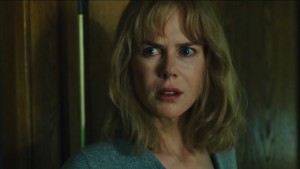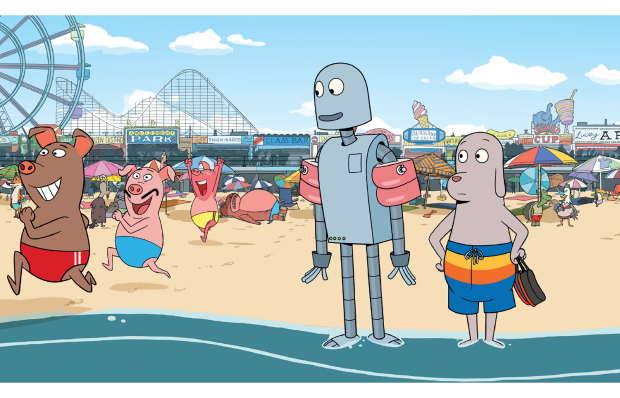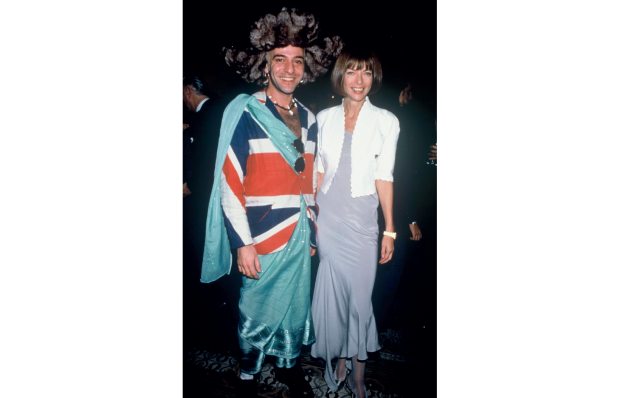Before I Go To Sleep is Rowan Joffe’s adaptation of S.J. Watson’s bestselling thriller of 2011, but whereas the book was smart, gripping, ingeniously plotted and had psychological depth — who are we, when we can’t remember who we are? — this is a disappointment on so many levels. It’s not as if it’s even set in Crouch End, north London, any more. According to my press notes, Crouch End was not deemed sufficiently ‘cinematic’, which has to be upsetting, if you live in Crouch End, as I do, and have always said to people, ‘Come on over. You’ll love it. It’s just so very cinematic round here’, but there you are. I suppose I’ll learn to live with it, as uncinematically as I can.
The film, which is now set in a modernist 1960s house in an unspecified UK location — oh!; how cinematic! — opens rather brilliantly, with a sudden jolt, with the close-up of a single, startled, bloodshot eye. The eye belongs to Christine (Nicole Kidman), who wakes up every morning and doesn’t remember that the man in bed next to her is Ben (Colin Firth), her own husband, so no wonder she is shocked. Christine suffers from ‘atypical psychogenic amnesia’, which means that ever since she incurred a head injury, 13 years earlier, she can’t store new memories. She can hang on to information until she goes to bed, but by the following morning it’s all been wiped. ‘You store up information for a day, wake up, and it’s all gone,’ Ben tells her, wearily, for the umpteenth time.
He then leaves for work, and the phone rings. On the other end is a man who identifies himself as Dr Nash (Mark Strong). He tells Christine that he’s the neuropsychologist who has been helping her, without Ben’s knowledge. Christine, aided by the video diary Dr Nash insists she records every day, begins to recall little fragments of her past. Was her brain injury caused by a car accident, as Ben has said, or was she violently attacked? If so, who was her assailant? Whom should she trust, her husband or the doctor?

Joffe, who four years ago gave us that wholly unnecessary remake of Brighton Rock, goes straight for the suspense, packing in every suspense trope you can think of: swelling music; sudden noises; door handles turning; creepy car parks. (Dr Nash, particularly, seems to have a thing for creepy car parks; he may need to see a doctor himself.) But it never feels suspenseful. You may say it’s because, having read the book, I could anticipate the plot twists. But, such is my own pathetic memory, I had actually forgotten the main twist at the end, yet still did not experience any genuine sense of peril, any edge-of-seatness. Much of it just seemed improbable. A particular scene between Dr Nash and Christine, in a creepy car park, seemed so ludicrous, in fact, that the audience at the screening I attended actually laughed. Oh dear, I thought, that’s done for it.
Joffe has, for whatever reason, ditched not only any exploration of the relationship between memory and identity, but also Christine’s narrative voice; he has opted for the cinematic at the expense of all feeling. The book was written as if it were Christine’s journal, so you not only got an idea of who she was as a character, but your sympathies were with her. That journal has been swapped for the video diary here — fair enough; even I can see journals aren’t filmic — but her quick pieces to camera don’t give you anyone to care about. So what you are left with is plot, and when you are left with plot, what you start seeing are all the plot holes: no one has ever bothered to keep tabs on Christine’s whereabouts? No friends, relatives, care agencies? If her memory troubles date from the head injury, wouldn’t she remember whom she had known previously? How come she doesn’t know who she is every morning, but always knows how to operate a mobile phone? Also, that modernist house — the one so not in Crouch End — with its modernist furniture and modernist lighting and modernist art has to be worth millions. Ben is a teacher, so how has it been afforded? (Not a plot hole as such, but it’s one of the things you will start questioning when you start to drift, as you will.)
In short, it’s the sort of film during which you think about everything you shouldn’t be thinking about during a film. And the performances don’t help. Both Strong and Firth, who are otherwise so dependable, seem detached from the material, as if they don’t much believe any of it themselves, while Kidman, who is in every frame, appears to have laid off the Botox — at one point, her face looked like those leftovers you keep in Tupperware in the fridge — but is only required to perform two expressions: distrust and distress, often combined as distrustful distress. So, a disappointment, although, to put it into perspective, it probably won’t be the greatest disappointment in your life. Being told your hood is uncinematic. That’s the one that truly hurts.
Got something to add? Join the discussion and comment below.
Get 10 issues for just $10
Subscribe to The Spectator Australia today for the next 10 magazine issues, plus full online access, for just $10.
You might disagree with half of it, but you’ll enjoy reading all of it. Try your first month for free, then just $2 a week for the remainder of your first year.













Comments
Don't miss out
Join the conversation with other Spectator Australia readers. Subscribe to leave a comment.
SUBSCRIBEAlready a subscriber? Log in